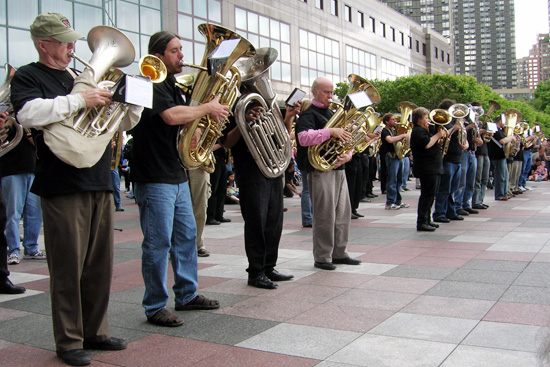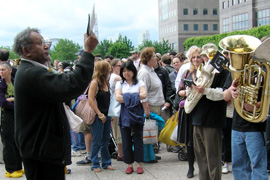Professors, Alumni Perform and Direct in Tuba Ensemble in New York
 |
|
Pictured at left, Stewart Gillmor, professor of history and science and professor of science in society, performs during The Bang on a Can Marathon June 4 in New York City. Below, Anthony Braxton, professor of music, directs the band. Braxton wrote the band’s composition. |
| Posted 06/16/06 |
 Strutting outside the World Financial Center in New York City, Stewart Gillmor bellowed his five valve double-belled euphonium for thousands of spectators. He was one of 75 tuba players to march in the annual The Bang on a Can Marathon June 4 in New York City. Strutting outside the World Financial Center in New York City, Stewart Gillmor bellowed his five valve double-belled euphonium for thousands of spectators. He was one of 75 tuba players to march in the annual The Bang on a Can Marathon June 4 in New York City.
Gillmor, professor of history and science and professor of science in society, is a member of the Tuba Marching Band, directed by Wesleyan Professor of Music Anthony Braxton. Braxtons band performed his own opus, Composition No. 19, a marching piece for tubas. It was quite a show, and quite a good, avant-garde thing to do in New York, Gillmor says. With a baton in hand, Braxton led the tuba band with co-conductors and Wesleyan alumni Taylor Bynum 98, James Fei 99 and Matthew Welch 01. Each conductor led a quarter of the band, with players horning with old European instruments called helicons, and sousaphones, tubas, mini-baritones and euphoniums. Gillmors euphonium was rare. Most have three or four valves, but his 1940 Holton-brand has five, which allowed him to switch between two horn bells with the fifth key. It is one octave higher than that of a tuba. There were several real musicians there, some were symphony musicians, but most of us were not professionals, Gillmor says. Most of us were aspiring artists. It was a very geeky group. The uncomplicated melody of Composition No. 19, included fluttering notes, growls, 10-second solos, whispery sounds and several blab, blab, blab, sounds, Gilmore explains. In addition to Braxtons tuba band, performers included Julia Wolfe’s piece for six pianos; Yat Kha, a Tuvan-throat-singing Siberian punk band; Amiina, the all-female Icelandic ambient quartet; Bang on a Can drummer David Cossin with Wilco drummer Glenn Kotche; Björk collaborators Matmos with So Percussion; Evan Ziporyn’s Gamelan Galak Tika; cellist Maya Beiser; the group Alarm Will Sound; and Aphex Twin, among others. The show finished inside the Winter Garden. Braxtons group, which is made up of tuba and low brass players from New Jersey, Connecticut and New York, had only two rehearsals prior to the performance, one the day before, and then again on the day of. We sounded pretty good and the audience seemed to really like us, Gillmor says. |
| By Olivia Drake, Wesleyan Connection editor. Photos by Stewart Gillmor III. |

